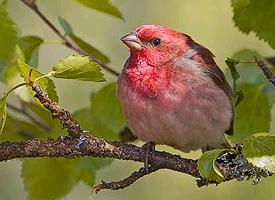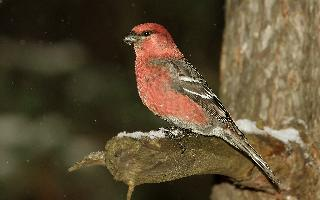
Állatleírás
The Common Rosefinch, scientifically known as Carpodacus erythrinus, is a small yet captivating bird that belongs to the finch family, Fringillidae. This species is particularly renowned for its striking plumage and melodious song, making it a favorite among birdwatchers and nature enthusiasts alike.Adult males of the species are easily identifiable by their vibrant crimson or rose-colored breast and forehead, which contrast beautifully against their darker, brownish-black wings and tail. The intensity of the red may vary among individuals, with some showcasing a more pronounced hue than others. Their back is usually a soft brown, blending seamlessly into the brighter colors of their underparts. The males' striking coloration not only serves as a means to attract mates but also to establish dominance over rivals during the breeding season.
Females and juveniles, on the other hand, display a more subdued color palette. They are primarily brown and heavily streaked with darker markings, allowing them to blend into their surroundings and evade predators. Despite their less conspicuous appearance, the intricate patterns of their plumage possess a subtle beauty.
Common Rosefinches are small to medium-sized birds, measuring about 14 to 16 cm in length. They have a robust body, a strong conical beak adapted for seed eating, and a notched tail. Their physical adaptations are a testament to their resilience and versatility in foraging across various environments.
The species exhibits a wide geographical range, spanning across Europe, Asia, and parts of the Middle East. During the breeding season, they favor deciduous forests, woodland edges, and gardens, where males can be heard delivering their distinctive, melodious song from a prominent perch. The song, a series of sweet whistles, plays a crucial role in courtship and territory defense.
In winter, Common Rosefinches migrate southwards to warmer regions, including the Indian subcontinent and Southeast Asia. This migratory behavior ensures that they can exploit different ecological niches and food sources throughout the year.
Diet-wise, the Common Rosefinch is primarily granivorous, feeding on a variety of seeds from grasses and trees. However, during the breeding season, they also consume insects, which provide essential protein for the growth of their chicks.
Breeding typically occurs from late spring to mid-summer. The female is solely responsible for constructing the nest, which is a neat cup-shaped structure made of twigs, grass, and moss, and lined with finer materials. It is usually placed in a concealed location within a shrub or low tree. After laying 4 to 6 eggs, the female incubates them for about 12 to 14 days. Both parents partake in feeding the hatchlings, which fledge the nest approximately two weeks after hatching.
Despite facing threats from habitat destruction and changes in agricultural practices, the Common Rosefinch is currently listed as Least Concern by the International Union for Conservation of Nature (IUCN). This status reflects the species' wide distribution and relatively stable population size. Nonetheless, continued monitoring and conservation efforts are essential to ensure that these vibrant birds remain a common sight in
Hasonló állatok
Új állatfotók
Top 10 állat
- Dolphin gull (Leucophaeus scoresbii)
- Diana monkey (Cercopithecus diana)
- Moustached guenon (Cercopithecus cephus)
- Galápagos tortoise (Geochelone nigra complex)
- Stone loach (Barbatula barbatula)
- Japanese macaque (Macaca fuscata)
- Greek tortoise (Testudo graeca)
- Russian tortoise (Testudo horsfieldii)
- Common flying dragon (Draco volans)
- Galápagos penguin (Spheniscus mendiculus)


